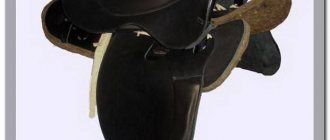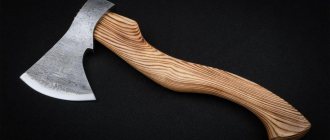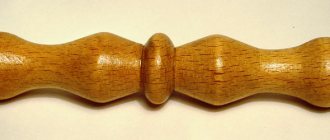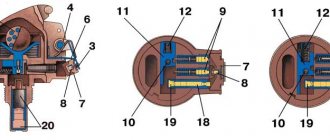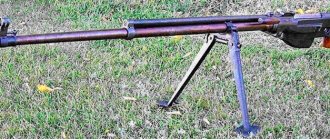Home » Real story » History of Wars » Throwing weapons of antiquity
History of Wars
admin 06/08/2019 10144
20
in Favoritesin Favoritesfrom Favorites 3
There is an opinion that throwing weapons are an invention of historians, that with the materials existing at that time, such machines are generally impossible to build. But there are quite workable modern reconstructions. I am not a supporter of either theory simply because each design must be approached separately. I am only presenting to you an attempt to systematize throwing weapons.
If you put together the names of throwing weapons of antiquity, you will get an impressive list of many dozens of terms (even if you do not take the exotic languages of the East). Palinton, onager, scorpion, angen, fundibul, espringal, robinet, mangonel, calabra... It doesn’t take long to get confused in all this splendor and decide that there are about as many types of siege weapons as there are varieties of swords. But this, of course, would be a mistake.
Operating principles of siege engines
All throwing machines, except the siphonophore, can be divided into three categories according to the force used to launch the projectile.
Tension machines work in the same way as a bow: by straightening, the machine's arm sends the projectile forward. This method is great, so to speak, “in small forms,” that is, for hand-held and light stationary weapons, but as the size increases, it turns out that it is very difficult to choose the right parameters for the bow. In addition, the bow often breaks in the process - with very, very unpleasant consequences. Tension machines are the lightest of all.
Torsion bar machines use a more cunning method. A lever is inserted into a bundle of stretched oxen tendons or ropes and rotated until it produces the required tension force. Then it is further turned by the charging mechanism, and when the lever is released, the force of the twisted wires sends the projectile. A torsion bar machine is a much more advanced and complex technology, but it provides significantly more possibilities.
It can be difficult to immediately imagine the operation of a torsion bar machine; but try stretching a regular rubber band between the fingers of both hands, inserting a pencil into it and twisting it. The principle will immediately become clear...
Finally, gravitational machines operate on normal gravity - that is, a counterweight launches the projectile. This design is justified only for the largest machines, when it becomes impossible to achieve the required force from the torsion bar circuit.
In fact, science knows only four types of pre-firearm throwing weapons (we exclude hand weapons - bows, crossbows, slings - from consideration). These are the catapult, ballista, trebuchet and siphonophore. And all these calabres, robins and onagers are simply varieties of the first three of them. Siphonophores were successfully used by only one people, and therefore cannot boast of an abundance of subspecies.
It often even turns out that the next “new type of siege weapon” is nothing more than the proper name given by the soldiers to their favorite ballista. Thus, in later times, the Italian condottieri called each bombard or cannon by name; throwing weapons of antiquity were less often awarded personal names, but it still happened...
Here it should be noted that ancient chroniclers and historians introduce considerable confusion into the classification of siege weapons. After all, it’s impossible not to mention the machines that threw stones during the legendary siege of such and such a fortress, but... the historian himself has never seen this machine. But he has a good idea (as it seems to him) of her externally and wants to convey this information to his descendants.
So miracle drawings appear, depicting a mechanism that no engineer in the world can make work. Polybius, for example, is especially famous for such pictures, who left us the most valuable information about Roman military science during the Punic Wars. Vegetius, a noble warrior, had great problems with proportions when drawing. And descendants wonder: what the hell did these ancients arm themselves with?
Another thing is Leonardo da Vinci: this one, undoubtedly, understood weapons and knew how to draw - God forbid to everyone. But here, too, bad luck: the great Tuscan had a very rich imagination and drew not only what was used in reality, but also what his own imagination invented. His devices work great, but it is not always possible to understand whether they were built in reality...
A small part of the huge potential for delivering death
Officially, throwing weapons are a separate subtype of bladed weapons. All throwing bladed weapons can be classified into two categories based on the principle of force used: muscular and mechanical.
- Muscular category. Such weapons work due to human muscle power in direct contact with the weapon. This category includes axes, knives, darts, spears, shakens and shurikens, arrows, chakras.
This category, in turn, can be divided into two subtypes:
- throwing weapons - designed for throwing, but if necessary can be used for close combat;
- conditionally throwing weapon - intended for close combat, but if necessary can be used for throwing.
- Mechanical weapons. To throw a projectile, auxiliary devices are used that work as levers or due to the elastic properties of wood and animal fibers. These are a bow, a sling and a bolas, a crossbow, a spear thrower and all types of pre-powder artillery (catapult, ballista, trebuchet, onager, etc.).
This category should also be divided into two subtypes:
- personal weapons;
- collective throwing weapons.
Ammunition for throwing weapons is extremely diverse; this includes both spherical objects with crushing action and weapons with piercing and cutting action.
Ballista
A ballista throws arrows or stones in much the same way as a crossbow. The bowstring, tensioned by a special mechanism (a banal hook or a goat's leg is not enough here!), bends the ballista's shoulders, then it is released, and the shoulders, straightening, send a stone or arrow forward.
The word "ballista" comes from the Greek verb "ballein" - to throw, to throw.
Until the 4th century BC. the catapult was called a ballista, and the ballista was called a catapult. Then, due to some not entirely clear circumstances, the names changed owners. This confusion has pretty much spoiled the blood of historians!
Most ballistas do not have a single bow like a crossbow, but rather two separate arms. Often the arrow is sent not by the bend of the shoulder itself, but by another force: the shoulder is attached to a twisted rope. This is called a torsion machine. But there are also a lot of light tension ballistas.
The ballista is most often cocked with an ordinary collar, like a well collar, on which a rope with a hook is wound - the hook holds the bowstring. The hook designs were quite intricate - there was even something like a carabiner lock.
Among throwing weapons, ballistas are the lightest and most mobile. Therefore, it is not surprising that they were found on ships, and even in the “horse” version (like later horse artillery). Such devices were called carroballistas. (There were also mobile catapults, but they had to be pulled by a team of several oxen, and they could not be called truly “mobile.”
Carroballistas became an indispensable element in later Roman tactics: for example, Vegetius reports that each century is required to have one such machine, powered by 11 soldiers (hence, the legion carries with it 60 carroballistas).
There is a myth that ancient siege weapons were used only during assault. In fact, the Romans realized that ballista works wonders against large crowds of people, and they did not hesitate to use it even in an open field.
Another advantage of this weapon is its fairly high aiming ability. Experienced soldiers send cannonballs quite accurately from catapults, but they still need decent aiming. Some ballistas had two combat modes - targeted and long-range; in the latter version it was quite possible to hope for a 500-meter flight of the projectile! The record for the range of the ancient ballista is just over 700 meters. Aiming was achieved at much shorter distances - about 100 meters, maximum - 200.
The power of a shot of a ballista, of course, cannot compete with a catapult or trebuchet. But the arrow flies along a relatively flat trajectory, and you can try to hit it right at the gates of the fortress; but with a catapult core flying in a high arc, this can hardly be done.
Among the types of ballistas are:
Questions
1. What throwing machines initially began to be called catapults in Ancient Greece:
- gastraphetes
- oxybeles
- euthytons
- palintons
2. The design of which throwing machine is borrowed from the medieval crossbow:
- gastraphetes
- oxybeles
- euthytons
- palintons
3. Which of the throwing machines used a torsion bar as an elastic element:
- gastraphetes
- oxybeles
- euthyton
- palinton
- onager
- trebuchet
4. Look at the photo of the catapult, which was assembled using the Lego EV3 set. Which ancient throwing machine has the most similar features to this device?
- gastraphetes
- oxybeles
- euthyton
- palinton
- onager
- trebuchet
Throwing machine from educational construction set Lego EV3
Gastraphetes
This is the oldest Greek ballista - more precisely, a cross between a ballista and a crossbow. The name means "belly bow" in Greek. Gastraphetes imagines a crossbow so large that it is impossible to hold it in his hands, and therefore he is supported on the ground with a crutch, and the butt covers his stomach in a wide arc.
They were armed with such a miracle shortly before the Macedonian conquest, and Alexander’s army also had enough of them. But they were soon improved, and... appeared.
Oxybeles (easel bows)
The Greek “oxybeles”, or easel bow, is a logical development of the gastraphetus to increase its penetrating power and firing range. The heavy mechanism was installed on a carriage - a supporting frame for the gun. Loading of such a weapon took place using a gate - a drum with levers, on which a rope was wound, tensioning the bowstring.
Ancient Greek oxybeles - a arrow thrower, reminiscent of a gastraphetus, but mounted on a carriage
Arcballista
The Arcballista, also known as the Oxybel, is still a giant crossbow, a tension machine. But she already has a real machine and a big collar. The projectile is a special heavy arrow.
They also talk about a large arcballista, where the string was moved by six vertically placed bows. But this is most likely a myth: it is mainly the authors of the late Middle Ages who write about it, and they write about it as if it were from hoary antiquity, and there is no reason to believe that they knew what they were talking about.
Arcballista is by nature quite limited in its capabilities; and the point is not only in the tension scheme, but also in the lack of the ability to change the angle of the bed. This cuts the range down to about 40-60 meters; not serious!
Modern bladed throwing weapons
Nowadays the most popular bladed weapons are crossbows, bows, throwing knives and axes. Shakens are famous thanks to Hollywood films. All these weapons are used for sporting and hunting purposes. Different peoples and cultures also use their national types of weapons.
Special forces and reconnaissance units are armed with knives and crossbows. Although modern silent firearms are much more effective, cold weapons help get out of a difficult situation.
To successfully use cold throwing weapons, intensive training of many skills is required: coordination, eye, vestibular apparatus and physical fitness, psychological stability and knowledge of the characteristics of the thrown weapon.
In a stressful situation, competently hitting the enemy with the last remaining means of defense is a rather risky undertaking.
Throwing knives are used in sports competitions. Such products are exclusively all-metal and reach 30 cm in length. Axes are also lightweight to a minimum and are thrown mainly at a distance of 15 m.
Palinton and Scorpio
Palinton
A palinton is a two-armed torsion ballista that throws stones (sometimes all stone throwers are called palintons, based on the origin of the word). The cores into which the lever arms are inserted are fixed on a rigid rectangular wooden frame.
The pallet was mounted on a clever tripod, which made it possible to rotate and tilt the gun, quite accurately fixing the angle. This same tripod allows you to overcome the main drawback of the arcballista and provides the weapon with a firing range measured in hundreds of meters.
Scorpion
Scorpio differs from palinton in that it throws arrows, not stones; Otherwise, the structure of the machine has not changed. It is also called eutiton (literally “arrow thrower”). Heron subsequently tried to improve the scorpion by making his own design, the cheiroballista; it didn’t really catch on, but it gave rise to a whole family of crossbows.
Palinton and scorpion are the two main ballista designs that have existed for over a thousand years. Their popularity lasted until the 14th century, and in some places longer.
Conditional throwing
Battle axes and knives differ significantly from their throwing counterparts. With good training in throwing, you can effectively use an ax to chop wood.
A battle ax is heavier than a throwing ax, due to which it has a great advantage and disadvantage: such a weapon is thrown heavier and flies slower, but the impact and penetrating force is more powerful. You can hone your basic ax throwing skills and gain a general understanding of the craft in just a week.
Suffice it to recall the axes of Askold’s squad and the Vikings. This weapon is now known as the Danish battle axe. This is a full-fledged battle ax with a handle up to a meter, the blade of which had a convex shape.
The ax could be thrown at the enemy, and then finished off with a sword, or the ax could be used as the main weapon.
A combat knife, unlike a throwing knife, is not suitable for throwing. The balance of a good combat knife is shifted towards the handle, this makes it more confident to operate it in close combat.
The blade of a combat knife is hardened; if it hits a bone or stone, there is a high probability of being left without your combat comrade. But, nevertheless, it can be thrown at the enemy, but only if there are no more suitable options for victory.
Spear, the main weapon of a Stone Age warrior. Initially, the spear was used both for throwing and for close combat. Later, spears were divided into two types, spears for throwing, which could also be used in close combat - sulitsa, for example.
Weapons intended only for throwing are darts and pillums. And spears and pikes, intended only for hand-to-hand combat. They differed in both tips and shafts.
Polyball
The dream of making a weapon that shoots quickly has existed since ancient times, and almost every shooting thing had its own Gatling or Maxim. The rapid-fire crossbow was born in the East, but the rapid-fire ballista was born in Alexandria, and even the author of the idea is known - the well-known Dionysius.
The polyball (also known as polybolos) has two original parts: a mechanism for arrows, approximately the same as in the cho-ko-nu crossbow, and a gear wheel that cocks the bowstring (its invention is often mistakenly attributed to Leonardo da Vinci). Of course, one cannot count on truly great power from such a weapon; Probably, this and manufacturing difficulties were the reason why the polyball never became a mass machine.
Catapult
The catapult has a large lever, one end of which is attached to the axis, the other is free. The free end is equipped with either a spoon or a “basket” on ropes like a sling (it is often called a sling); a projectile is placed in this spoon or basket - usually a large stone or, less often, a special cannonball (in some places clay jugs with Greek fire were also used).
Most catapults are powered this way. The axle to which the lever is attached is attached to bundles of strands or ropes (torsion method) and twisted almost to the limit; The collar pulls the lever down, twisting the ropes even more. Then the lever is released and it sends the cannonball flying.
The projectile, naturally, flies along a hinged trajectory, the accuracy is moderate, but it is easy to throw it over the wall. The mass of the projectile is 20-40 kilograms, sometimes even up to 50-60.
The word “catapult” was originally the same root as “ballista”, although you wouldn’t guess it from its current sound. “Kata” means “against”, “to fight something”, and “remote” is the same corruption of “ballein”, that is, “to throw”.
The typical range of a catapult is about 300-350 meters.
Sometimes these machines were assembled right on the spot from trees found right there (they only took metal parts and ropes with them). The Romans, however, preferred to carry catapults with them as heavy artillery (ballistas were light). But it was impossible to ride them quickly on horses - they harnessed the bulls, as in the 19th century, to siege cannons. And the legion relied on only 10 catapults. Cars were often transported disassembled.
The main purpose of the catapult during an assault is to attack walls and towers (the ballista can select smaller targets, but will not break through a serious wall). It was usually placed on the fortress wall to fight siege towers - you cannot find a better tool. Catapults were also used in the navy - primarily for throwing Greek fire, until a better way was found. The ship is too nimble a target for a slow-cocking, slow-aiming catapult.
Firing from this vehicle is much more difficult than from a ballista, and qualified artillerymen were highly valued.
In the Middle Ages, the catapult replaced the ballista because 300-350 meters was both its maximum and target range. And this is greater than the flight distance of an arrow from an English bow or a Genoese crossbow fired from the height of a castle wall. Which became the decisive advantage. However, complete displacement did not happen.
Classic throwing weapons
The most widely used weapons in this category are throwing knives. A feature of their design is the material; they are often made in the form of an all-metal product.
In fact, this is a balanced plate or rod made of metal, sharpened on one or both sides; the blades of such knives are made of unhardened steel, this is necessary so that the blades do not break when hitting hard surfaces. The balance of the knife is shifted towards the tip, which is why the blades of these knives often have a leaf-shaped shape.
This knife does not need a handle and a cross, although sometimes the simplest types of braiding are found in the form of a rope tie or a wooden lining.
But these are most often combined specimens, intended, among other things, for utilitarian use. The weight of the knife is close to the weight of a combat knife and is 250-300 grams. Throwing range up to 6 meters.
Arrows were the throwing weapons of eastern masters. They were short pointed pyramids in the form of miniature arrowheads with a small shaft.
Fabric strips or feathers on the shaft served to stabilize the arrow's body in flight. The main purpose of their use was to distract the enemy during the battle. An object thrown at the face forced the enemy to deviate, or knocked down his fighting spirit, which made it possible to deliver a decisive blow with the main weapon at that time.
Shurikens are often called those same deadly flying “stars” when the ancient Japanese special forces - the ninja - are mentioned. But this formulation is erroneous: shurikens are throwing blades that have their own extensive type group.
Often they are made in the form of household items, which made it possible to disguise them under clothing or among ordinary things. These are blades in the form of nails, coins and other variety of objects found around the ancient thrower.
Shakens are throwing “stars”.
The plate, the blades of which are directed with arrow-shaped rays from the center, resembles a star. The dimensions of the shakens were not standardized and were made taking into account the conditions of their use.
Ancient hand-held throwing weapons were decorated with symbols and hieroglyphs to imbue them with mystical energy and give strength to their thrower.
Shakens were effective only at close range (up to 10 m), and small specimens were intended solely to intimidate, distract or disorient the victim, which gave a tactical advantage to the thrower. According to some sources, the creation of shakens was inspired by Chinese arrows laid out in a circle.
Another interesting eastern ancient throwing weapon is the Indian chakras. Just an ordinary ring with a diameter of up to 30 cm and a plate thickness of up to 5 mm, sharpened along the entire outer edge.
It is untwisted from the inside with your fingers and launched into a crowd of softly armored, or better yet, relatively naked enemies. Before the battle, chakras were hung on the hands or thrown over a pointed cap. The combat flight range reaches 50 meters.
We must not forget the famous boomerangs, unlike the listed samples, this is a subtype of impact-crushing weapons.
Contrary to the well-known myth about the returning boomerang of the Australian aborigines, these throwing clubs were widespread; moreover, combat and hunting versions of boomerangs did not return to the owner after flying, but remained with the enemy’s body.
Onager
The onager is the most popular catapult of ancient Rome. Its only peculiarity is a basket on ropes instead of a spoon, which is more common in Greece.
The word "onager" means "wild ass". There are at least three versions about why the catapult was equated to a donkey. According to the first, the wild ass drives away predators by throwing stones at them with its hind hooves. This phenomenon is unknown to modern zoology, but the ancients had strange views about the behavior of animals... The second version claims that the catapult lever shoots up like the leg of a kicking donkey; Associations are an individual matter, of course, but the comparison is very strange. Finally, the third version, relatively plausible, says that the device worked with a heartbreaking creak, reminiscent of a donkey's cry.
The fighting donkey survived into the Middle Ages; however, there he acquired the nickname “Mangonel”. Over the years, the machine shredded, but learned to shoot something like buckshot; invaluable against dense formations!
Espringal
Quite a rare combat vehicle: a catapult based on the tension principle. Its lever is elastic, the collar bends it, and the lever, straightening, throws the stone (it is placed in a bag or basket). Apparently, the most successful scheme belongs to Leonardo, but we find the first known example in Flavius Vegetius.
Making espringal (also known as springald) is difficult; it is inferior in strength to an onager; True, it’s quite long-range. There is also the advantage that espringal almost does not need to be shot after installation. But still, these devices have never been very popular.
There was also an arrow thrower based on the same principle - it was called a brekol. They say that at 300 steps he pierced through a 15-centimeter log, but in fact he launched an arrow at 1300 steps. True, these statements are very doubtful.
Trebuchet
This achievement is no longer ancient, but medieval thought: it appears only in the 12th century, at the end of the era of pre-firearms. The word means in Old French "to throw over something." In Latin the same unit is called a frundibulum, in Italian a frontibola.
Gradually, the fortification improved, and locks began to appear that could be hammered with an ordinary catapult for almost years. And the need arose for more powerful weapons. Which was satisfied by the unknown French inventor.
(According to another version, the trebuchet was first invented in the East, and then through the Persians, Arabs and Byzantines the device arrived in Europe. But this idea was not confirmed; among other things, Byzantium recognized this machine clearly later than France. It even got to the point that the carriers they tried to declare ideas... our ancestors, the Varangians and Slavs. But even here it doesn’t work: the Varangian fighting machine is certainly not a trebuchet.)
Trebuchet contains no flexible elements at all. This is a gravity machine: the lever is driven by a counterweight.
For such a system to provide an advantage over a torsion bar system, a truly gigantic scale is needed; That's how it was. The lightest trebuchet counterweight pulled 400-500 kilograms, and sometimes a ton or two. Well, the projectile, of course... 150 kilograms - this trebuchet has only just begun. Later machines were capable of throwing, for example, a dead horse - and this is already half a ton. The record for the mass of a projectile that your humble servant has ever read about is 630 kg! The range is slightly superior to a catapult: 350-420 meters.
It is often said that during a siege, dead horses were thrown into fortresses for the sake of psychological effect. As for me, this is quite doubtful even for the sake of epidemics.
A medieval city dweller would not be embarrassed by the sight of a horse carcass. But since many people persistently denied the people of those times the right to imagine what spreads the infection, they came up with such a motivation, contrary to all evidence. Of course, psychic attacks also happened - then they threw the bodies of ambassadors or hostages, and Allaudin Khilji, during the storming of Delhi, threw bags of gold at the enemy fortress.
The power of the shot had to be paid for, firstly, by the bulkiness of the device (the lever is 20 meters long, other sizes are easy to imagine), and secondly, by a very long reload. It is very difficult to lift a couple of tons to the required height! One of the ingenious solutions successfully used by the French is a pair of “squirrel wheels”, inside which people – hundreds of people – are running.
Of course, using a trebuchet other than against fortress walls is extremely difficult - it takes a very long time to aim and shoot.
A highly simplified analogue of a trebuchet, without a counterweight, driven by simple muscular force, is called a perrier.
Siphonophore
This last type of medieval throwing weapon, strictly speaking, cannot be called “non-fire,” although it does not use gunpowder. He shoots with fire—Greek fire. In essence, this is a Byzantine naval flamethrower. It is also simply called a siphon.
Many people mistakenly believe that Greek fire was thrown exclusively from catapults. If this were so, he would never have provided the Byzantine fleet with such decisive superiority over all rivals. After all, a Mediterranean war galley is a small, fast vessel and very inconvenient for aiming. And even more so - a Varangian or Slavic boat.
They say that a certain Callinicus from Heliopolis invented the siphonophore in the 7th century AD.
This device is a fairly simple sprinkler pump. It is not necessary to aim accurately with the burning mixture - it is enough to hit the target, and all the “excess” will still fall on the sea waves and quickly burn out without causing harm (this is why Greek fire was rarely used on land - there is a high risk of starting a fire where it is not needed). The spray easily covers both a large ship and a boat.
As for me, this is a weapon from the realm of fantasy. Anyone familiar with the design of a flamethrower will certainly agree with me.
In addition, what Greek fire is is not known exactly, but it is clear that it is some kind of petroleum-based mixture. Oil was bought by the Byzantines in Zikhia, a country located in the territory of present-day Georgia and the south of the Krasnodar Territory. In all likelihood, those sources have long been depleted, in any case, there is no visible oil there today. And crude oil generally burns very poorly, and for some reason they were silent about distillation devices in those days.




